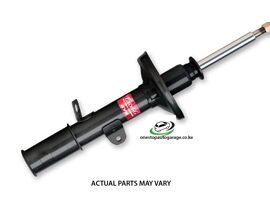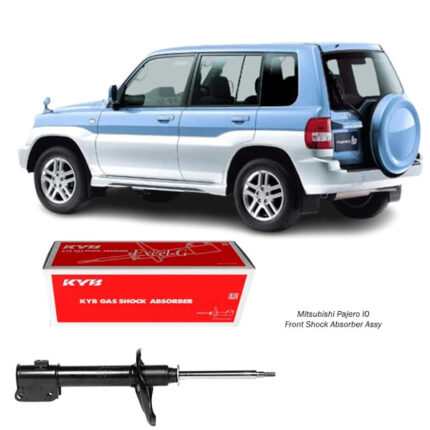-9%
Get Nissan Teana J31 Front Shock Absorber Assy 334404 in Kenya
In every smooth turn, stable brake, or confident cruise over bumpy roads, there’s a quiet hero at work — the Front Shock Absorber Assembly. While it may not grab headlines like engines or tires, it’s a vital part of your vehicle’s suspension system, responsible for absorbing road shock, enhancing stability, and keeping your ride controlled and comfortable.
Whether you’re gliding through city streets or navigating rough terrain, the front shocks are constantly at work to give you a balanced and predictable driving experience. Let’s break it down. 🧠🛠️
🔍 What is a Front Shock Absorber Assembly?
The front shock absorber assembly is a critical suspension component located between the front wheels and the chassis of your vehicle. Its primary function is to absorb and dissipate energy generated by road irregularities — like potholes, bumps, or uneven surfaces — and to control the movement of the suspension.
A typical front shock absorber assembly includes:
-
The shock absorber (damper) itself
-
Mounts and bushings to connect it to the suspension and vehicle body
-
Springs (in case of a MacPherson strut or coilover system)
-
Dust boots or bump stops to protect internal components
Together, these parts work to control suspension travel, reduce oscillations, and provide a smooth and stable ride. 🎯
⚙️ How It Works
Imagine driving over a speed bump. Without shock absorbers, your car would bounce wildly, making steering difficult and compromising safety. This is where the front shocks come in.
Inside the shock absorber is a piston moving through oil or gas. When the wheel moves up or down due to road conditions, the piston creates resistance, which dampens the motion. This energy is transformed into heat and safely dissipated.
The front shock absorber assembly:
-
Absorbs vertical impact from the road 🔁
-
Minimizes body roll and front-end dive during braking 🌀
-
Keeps tires firmly planted for better steering and grip 🔒
-
Ensures vehicle alignment and suspension geometry remain optimal 📏
✅ Key Benefits of a Healthy Front Shock Absorber Assembly
1. Superior Ride Comfort
Good shocks absorb harshness and smooth out road imperfections — from cobblestones to gravel. This makes your ride quieter and more comfortable, especially on long drives. 🌬️
2. Enhanced Steering & Handling
Front shocks are closely tied to steering performance. They ensure your wheels stay on the road for accurate cornering, sharp response, and consistent control. 🎯🛞
3. Improved Braking Stability
During hard braking, poor shocks can cause the front end to “dive,” which can shift weight forward and increase stopping distance. Good shocks evenly distribute braking force. 🛑
4. Tire Longevity
Worn shocks allow excessive wheel movement, leading to uneven tire wear and reduced contact with the road. New shocks help preserve your investment in good tires. 💸🛞
5. Overall Vehicle Safety
A properly functioning front shock assembly contributes to the effectiveness of anti-lock braking (ABS) and electronic stability control (ESC) systems. 🚨🧠
🔍 Signs of Worn or Failing Front Shocks
Like all car components, shocks wear out over time. Here are signs it’s time to replace your front shock absorber assembly:
-
🚫 Excessive bouncing after hitting bumps
-
💧 Leaking fluid from the shock body
-
🔊 Knocking or clunking noises from the front end
-
🌀 Nose-diving when braking or leaning during turns
-
🛞 Uneven or rapid tire wear
-
🚗 Steering feels vague or unstable
Even if you’re not seeing obvious symptoms, if your shocks have covered over 60,000 to 100,000 km, it’s a good time to get them inspected.
🧰 Types of Front Shock Absorbers
Different vehicles use different types of front shock absorber assemblies depending on their design:
1. Twin-Tube Shock Absorbers
These are the most common in standard cars. They consist of two cylinders (inner and outer) and provide a good balance of comfort and control.
2. Mono-Tube Shock Absorbers
These have a single cylinder and are often used in performance vehicles due to better heat dissipation and firmer damping.
3. Gas-Charged Shocks
Charged with nitrogen gas to reduce foaming in the hydraulic fluid, these offer improved performance and durability over traditional oil-only shocks.
4. Strut Assemblies (MacPherson Struts)
Many modern cars use struts in the front suspension. These combine the shock absorber and spring into one unit and support the vehicle’s weight while also absorbing shocks.
🛠️ Installation Tips
While replacing shocks is straightforward for experienced mechanics, front assemblies often involve:
-
Removing wheels and brake components
-
Supporting the suspension arm
-
Compressing the coil spring (if integrated)
-
Ensuring correct torque specs and alignment after installation
⚠️ Always replace front shocks in pairs to maintain even handling and ride balance.
🔧 OEM vs. Aftermarket Options
-
OEM (Original Equipment Manufacturer) shocks match your car’s factory settings, offering comfort and reliability for everyday driving.
-
Aftermarket or performance shocks may feature stiffer damping, adjustability, and stronger materials — great for off-roaders, tuners, or towing setups.
Your choice depends on your driving needs — comfort, load, performance, or durability.
📅 Maintenance & Lifespan
Front shocks generally last 60,000 to 100,000 km, but aggressive driving, rough roads, or heavy loads can shorten this. You should inspect your front shock assemblies:
-
During every major service 🔧
-
After hitting a major pothole or accident 🚧
-
If your ride quality suddenly changes ⚠️
Routine suspension checks help detect wear early and prevent damage to related components like control arms and steering systems.
🌍 Real-World Use Cases
No matter your vehicle type, front shocks are always working for you:
-
City Drivers: Navigate potholes, speed bumps, and stop-and-go traffic with ease 🛑
-
Highway Cruisers: Enjoy smooth, confident lane changes and braking at high speeds 🛣️
-
Off-Road Adventurers: Tackle rocks, mud, and inclines without compromising control 🏞️
-
Family Travelers: Keep passengers safe and comfortable, even on long trips 👨👩👧👦
🏁 Conclusion
Your vehicle’s Front Shock Absorber Assembly may not be flashy, but it’s a crucial part of every safe and comfortable drive. Whether you’re braking hard, turning sharply, or just cruising, it ensures your tires grip the road, your steering stays sharp, and your passengers ride in comfort.
Worn-out shocks reduce safety, wear your tires faster, and strain your suspension. Replacing or upgrading your front shock absorber assembly restores that confident, smooth feel — and adds years to your vehicle’s life.
So if your ride is bouncing, dipping, or clunking more than usual, it might be time to give your front shocks the attention they deserve.
Follow us on Facebook for more parts.



